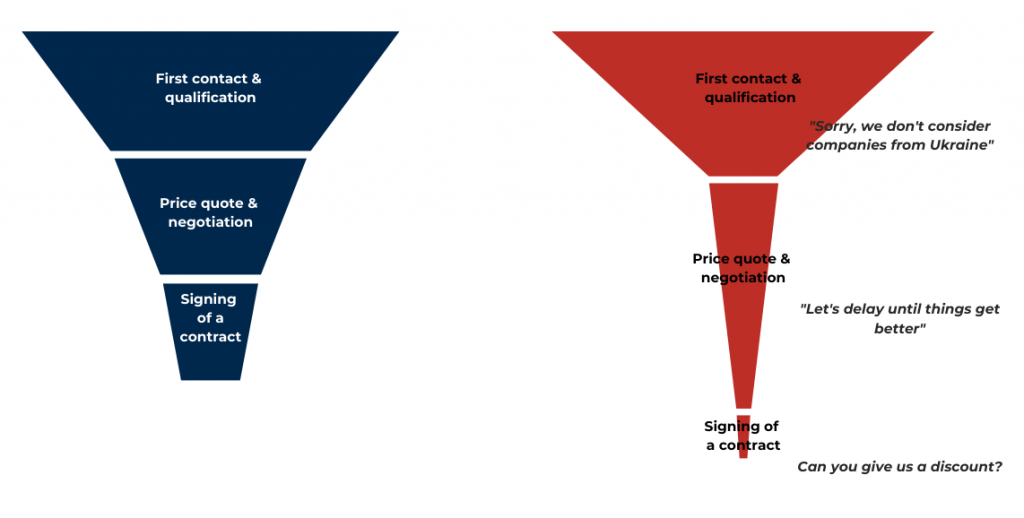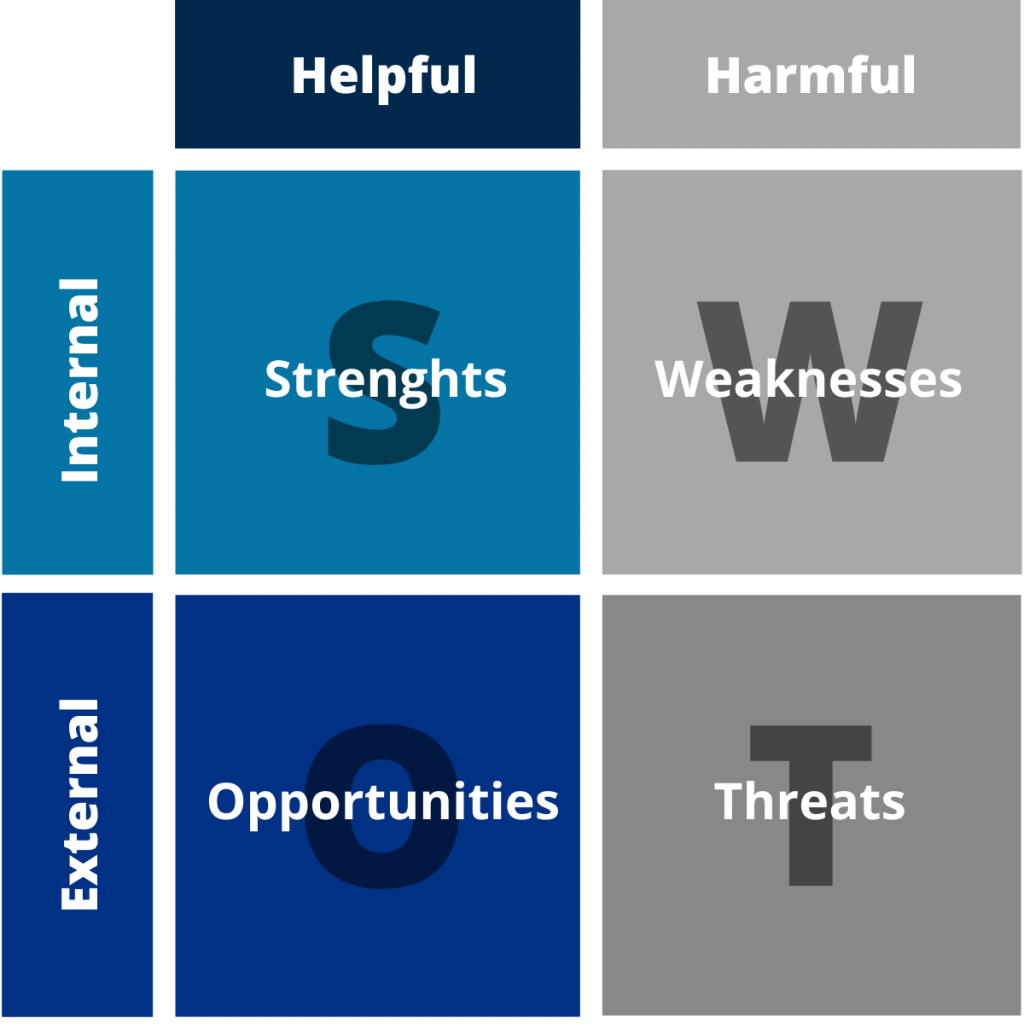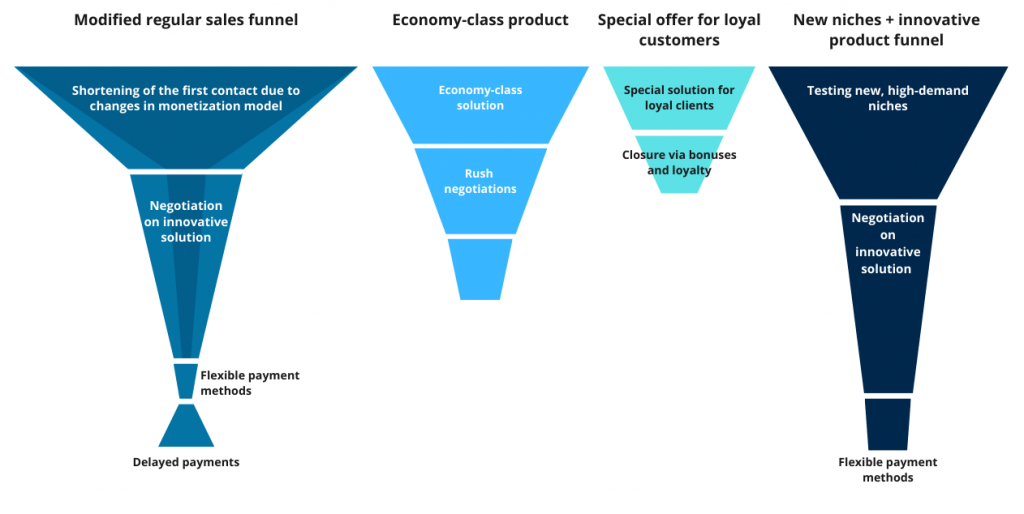It is sad but true: for all of us living through the 2020s, crisis is becoming our regular state of existence. Once we were able to breath a sigh of relief and pull our face masks off, a new, even more disastrous crisis came to Ukraine. The war has strongly affected local businesses, and its echoes will touch many other businesses around the world in the years ahead.
Thus, we’ve decided to return to the topic we discussed in our white paper that was published at the beginning of the COVID-19 pandemic. You can download it here.
The nature of this crisis is different, but the solutions have proven to be just as effective as before. So, we’ve decided to share our view and, maybe, help other businesses stay strong during war or any other crisis they encounter.
Sales in times of crisis
Most of us are familiar with the concept of a sales funnel (long story short: this is the illustration of a client’s journey from the first touch to the final deal). When circumstances require us to tighten our belts, this funnel does the same thing; it becomes thinner. And the deeper you go through it, the thinner it becomes.
Here is how we illustrate it:

The key patterns of the crisis sales funnel are as follows:
- Only a few will reach the second step. After all, many people know there’s a war happening in Ukraine. Still, not many of them know how it looks from the inside. While some regions lie in ruins, many businesses continue their operations away from the frontline or even in foreign offices. Ukraine is associated with high risks, even if it is only the destination where a company pays its taxes. People are afraid to work with Ukrainian businesses. And we fully understand their concern.
- Longer negotiations and suspended deals: Those who started working with Ukrainian firms before the war or are still willing to deal with local companies now have more risks and limitations to consider, so the decision process takes longer.
- Bargain for better terms: With risks increasing, clients need more perks from our side to balance out their concerns. Many such perks are negotiable, but some are not.
In such market conditions, acting like everything is normal probably won’t work. Thus, to stay competitive or even to outperform the competition, businesses have to adapt their strategies and tactics to the new reality. Below are a few experience-proven tips from Intersog.
A crisis is a time to reevaluate your strategy
Reality has changed, and the first thing you should do is accept this. Your next challenge is to re-evaluate the environment and rebuild your business to fit it.
We recommend starting with a SWOT analysis:

- Strengths
Strengths are things that your business does absolutely well or something that distinguishes it from competitors. It can’t be something you’re simply good at; it should be something that brings you a clear advantage. For example, if all of your competitors provide high-quality services, then that’s not your strength – it’s a necessity.
- Weaknesses
Weaknesses are something that you should improve upon or avoid in your organization. Be honest and realistic; knowing your gaps will help you get better in future. Think about what your competitors do better than you. What are you lacking?
- Opportunities
Opportunities usually arise from situations outside your organization. These are conditions or situations that can potentially bring you competitive benefits.
- Threats
Threats include anything that can negatively affect your business from the outside, such as supply chain problems, the potentially harmful actions of your competitors, and, yes, the potentially harmful actions of a hostile army. Pay special attention to factors that can make you vulnerable.
Once you’ve analyzed all the aspects of the SWOT matrix, you’ll likely have a list of potential actions to take. However, before taking first steps, look for potential connections between the quadrants. For example, some of your strengths may open new opportunities, or eliminating weaknesses may lead to avoiding some threats.
DIVERSIFY YOUR OFFER
In our whitepaper, we mentioned that diversification saved Intersog in 2020. In 2022, it once again became our life raft. Obviously, the demand for Ukraine-based specialists has decreased drastically due to increased risks, but since we had offices in the USA, Canada, Mexico, and a lot of engineers in Europe and Israel, we’ve moved most of our sales to these regions. As a result, we keep growing.
So, our advice here is as follows: treat your business like you do your stock market action – diversify your offer portfolio not only by niche, but also by region. You never know where the black swan will land next time.
WATCH FOR COMPETITORS
“If you wait by the river long enough, the bodies of your enemies will float by.” We all know this quote, but there’s more to it in the business sphere. Your enemies will definitely float by…on a powerful motorboat to the fishiest places.
When doing business, you should be well informed about what your competitors do — not only during crises, but always. Now, however, it’s more crucial than ever. Analyze how they react to the new market conditions. Have they produced new solutions, offers, or promotions? Are they exploring new niches or markets?
Knowing this information about your competitors will help you find ways to complement your own strategy, find new audiences, and, of course, develop your own distinctive features.
Check out a related article:
Top 3 Remote Team Management Challenges and Tips on How to Overcome Them
TEST YOUR IDEAS
Discuss your propositions with existing clients or prospects. Most likely, you’ll find a few people to talk to in your contact list or company’s CRM. If you're just starting out and don’t have contacts yet, you can try pinging potential clients via LinkedIn. The response rate will be much lower, though, than in the case of warm contacts.
This is a common indirect sales technique: when you don’t sell but simply ask for an opinion, people are more likely to respond. Through this discussion you’ll get reliable feedback on whether your offer matches the market need and whether the price is reasonable. You may also come up with new ideas and solutions based on the new data you’ve collected.
Operating in the same field as you, your contacts may also gain some useful insights from the dialog. So, it’s a win-win situation.
Develop the right tactics to reach your strategic goals
Once you’ve renewed and refined your strategic goals, it’s time to start bringing them to life. Sales during global change is hard, but consider it from the other side: buying is also difficult. Being uncertain about the future, buyers will think twice before dealing with your business. Thus, we’ve prepared a few selling tactics that can make the process smoother for both sides.
USE A PERSONALIZED APPROACH
Replace a shotgun with a sniper rifle. Spend some time studying your customer before addressing them. If your letter isn’t the next useless mailout but, instead, a hand-crafted, personalized offer, your client is more likely to respond, even if they are concerned about what is happening in your region. Moreover, if they are ready to support business in your region, you’ll get a warm lead.
OFFER EXTRAS
Offer your clients more than just a standard solution, which won’t work since you’re existing in circumstances that are anything but standard. Think of bonuses and extras you can offer to balance the newly arisen risks.
MAKE SPECIAL OFFERS FOR SPECIAL CUSTOMERS
We all have clients we hold near and dear (and so do they). Try to do more for this group of customers than you would usually do for others. Make them a special offer, provide individual rates, or launch a special loyalty program. Such customers are the pillars of your business. Each brand advocate is as good as gold. Even better, he’s as good as Bayraktar.
PROVIDE FLEXIBLE PAYMENT OPTIONS
People will be afraid to pay you in advance. Go a step further for them and offer an installment plan or a delayed payment option. Don’t forget to minimize your risks too, though.
TRY NEW SOURCES OF LEAD GENERATION
Research the places where your customers usually “hang out,” and try to reach them there.
Launch new campaigns, and try new channels, including remarketing. Make your reach as wide as possible in order to cover more of your target audience. Allocate no more than 10% of your Sales & Marketing budget to each channel when testing. This will help you get reliable results without risking large amounts of money. When you get the first performance data, you can focus on channels that bring better results.
DON’T FALL OFF THE RADAR
One of the major mistakes a business can make during a crisis is freezing its marketing activities. When you disappear from your prospect’s vision during hard times, you may disappear forever. So, even if your marketing activities won’t bring you sales in the immediate present, invest a small amount into SMM, email, or content-marketing just to remind your prospects that you still exist and care about them.
Wrapping up
Applying the above tips and tricks, we’ve come up with four new sales funnels. We call them our “Anti-crisis funnels”.

All of these solutions are experience-proven (two times already) and bring a lot of value if you follow the recommendations correctly. We advise applying them all or at least a few of them, even if you achieve good results with only one. The reason is the same: diversification. It’s always good to have a Plan B if Plan A suddenly stops working. Additionally, this strategy gives you the chance to positively affect a wide range of potential customers, build your reputation, and, of course, sell.

Leave a Comment